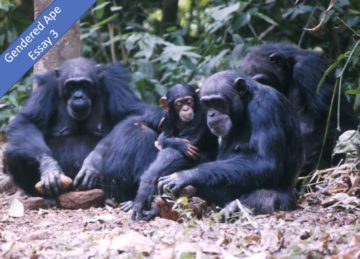Editor’s Note: Frans de Waal’s new book, Different: Gender Through the Eyes of a Primatologist, has generated some controversy and misunderstanding. He will address these issues in a series of short essays which will be published at 3QD and can all be seen in one place here. More comments on these essays can also be seen at Frans de Waal’s Facebook page.
by Frans de Waal

I’ve been told that gender is uniquely human, so what would be the point of comparing us with other species? They only have sexes.
I find this highly unlikely.
Jonas, a two-year-old baby, closely follows every bluff display by high-ranking males in the chimpanzee colony. Each male has a distinctive style, including spectacular jumps, hand-clapping, flinging objects, and breaking off branches. The alpha male often drums for minutes on end against a specific metal door to demonstrate his vigor. Mothers keep their little ones close throughout this racket, but let them go as soon as the performer calms down. Once released, Jonas runs up to the exact same door. With all his hair on end, he kicks it just like alpha had done. It doesn’t sound the same, but he has the right idea.
I’ve often seen male infants do so, never females. Young females rather follow the actions of adult females, such as their mother. I call it “self-socialization:” young primates emulate the behavior of adults of their own sex. They choose them as models. If their monkey-see-monkey-do mentality helps them develop sex-typical behavior, we could say that they have “genders,” too. Gender refers to the influence of the environment in shaping adult behavior, such as the expectations and norms surrounding the roles of men and women.
We are not the only species to learn from others and not the only one with culture. Yes, humans are marked by a slow development, which allows us to learn much while young. Keep in mind, however, that the great apes don’t develop much faster. Our closest primate relatives nurse for up to 5 years and are considered fully grown only around 16 years. They, too, have lots to learn and are therefore products of their environment.
Biological sex is divided into males, females, and a small in-between category. The deeper science delves into it, the more complex sex becomes, which is why talk of the “sexual binary” is a mere approximation. Gender is even more complex. In its most common definition, it is like a cultural coat that the sexes walk around in, a coat that changes from place to place and from time to time. Gender is not divided into male and female, but into masculine, feminine, and everything in-between. There is great variability. Many individuals show elements of both, and some elude gender labels altogether.*
Instead of the young being socialized by society, as many people believe, they may flesh out their gender roles largely by themselves through observation and emulation of models of the gender they identify with. If these models belong to the opposite sex of the one they were born as, the outcome will be transgender socialization, as proposed by Joan Roughgarden, a transgender biologist. Most youngsters, however, look up to and emulate adult models of their own sex. This tendency extends to fictive characters, such as when girls dress up like fairytale princesses and boys slay dragons with swords. How much children enjoy these reenactments was suggested by a neuroimaging study that found the pleasure centers in children’s brains to be activated by imitation of same-gender but not other-gender models.
Children have also been shown human actors, a man and a woman, doing simple tasks on a large film screen. The actors acted independently on different sides of the screen. The boys watched the man more, and the girls the woman more.
In our fellow primates, we have scattered evidence that the young selectively attend to same-sex models. For example, a recent orangutan study in the Sumatran forest by Beatrice Ehmann and colleagues showed that pre-pubertal daughters eat the same foods as their mother, whereas same-aged sons have a more diverse diet. Having paid attention to a wider range of models, including adult males, young males consume foods that their mother never touches.
Similarly, Elizabeth Lonsdorf observed how juvenile chimpanzees at Gombe National Park, in Tanzania, learn from their mother how to extract termites by dipping twigs into the insects’ nests. Daughters faithfully copy the exact fishing technique of their mother, whereas sons do not. Despite both spending equal time with their mom, daughters seem to watch her more intently during termite feeding.
These examples don’t yet amount to gender roles. It is much easier to measure tool-use and food habits in the forest than social attitudes and norms. But primate culture studies are evolving and will no doubt include social measures in the future. At the very least, current evidence suggests that young apes choose which adult models to emulate based on their own gender identity. Young males look for male models, young females for female models.
I would therefore not exclude gender socialization in our fellow primates, nor for that matter in other animals.
FURTHER READING
* On biological sex vs. cultural gender, see anthropologist Robert Martin: https://www.psychologytoday.com/us/blog/how-we-do-it/201908/no-substitute-sex
For further details and references to the literature, read “Different: Gender Through the Eyes of a Primatologist” (Norton, 2022). A video about the book is here: https://fb.watch/ffbauZBzNb/
